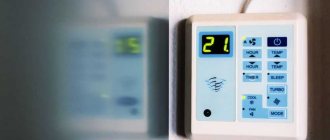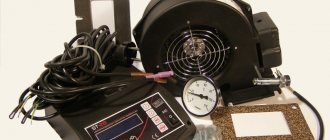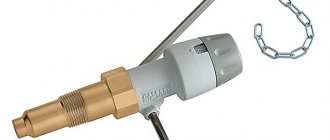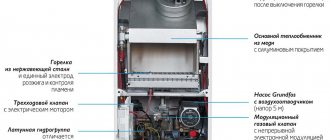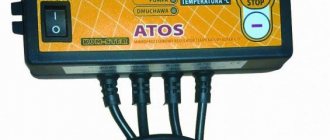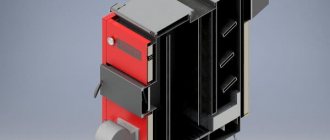Effective heating control is a vital part of running your boiler and home heating system efficiently. Proper use of controls will reduce the energy consumption of the unit, while creating a comfortable temperature in every room of the house, avoiding overheating of the premises. A thermostat (or programmer) controls the operation of the boiler depending on the room temperature.
Up to 20% of the volume of energy consumed can be saved by using this type of automation. And energy prices are quite high and every normal person wants to reduce their expenses.
We consider a situation where the boiler is calculated correctly, the necessary insulation of the premises has been completed, and the heating system is functioning normally.
Briefly about the principle of operation
To better understand the principle of operation of room thermostats, we first explain the operating algorithm of a water heating boiler in the basic configuration:
- The user ignites the heater and uses buttons or control handles to set the desired coolant temperature.
- Each device is equipped with a submersible or surface-mounted sensor that informs the control unit about the degree of water heating. When the coolant temperature reaches a predetermined threshold, the gas valve is activated and shuts off the fuel supply to the main burner. The circulation pump continues to “drive” water through the system.
- After the coolant has cooled to the lower temperature limit, the gas supply is resumed, the burner is re-ignited and heats the water.
Reference. In turbocharged wood boilers, the automatic system turns off the blower fan. The flow of air and the combustion process in the furnace are suspended, and the unit goes into standby mode.
Scheme of operation of a heating boiler with a remote thermostat - the automatic system stops and starts the burner depending on the temperature of the air, not the coolant.
Without an external temperature sensor, the heater “does not see” the air temperature in the rooms and stupidly heats the water to the specified limit. Result: during the transitional autumn-spring period, the so-called clocking is observed - frequent start/stop of the burner (once every 2-3 minutes), reducing the life of the unit as a whole.
Now about the main thing. A remote thermostat extends the intervals between turning on/off a gas boiler, since it focuses on the temperature of the air, which cools more slowly. The device is connected to the power supply circuit of the gas valve (turbines on TT boilers) and the built-in pump.
Installing an automatic thermostat allows you to kill three birds with one stone:
- reduce energy consumption;
- make boiler control more convenient;
- extend the life of the heat source.
Important note. The listed points apply not only to gas heaters. Any heat generator equipped with an electronic or electrical control unit is connected to the thermostat: solid fuel, diesel, electric boiler, and so on.
The automation unit of the wood-burning boiler has a connector for connecting the thermostat.
When the room warms up to the specified temperature, the thermostat breaks the circuit, the burner and the built-in heat generator pump stop. The unit starts up after the air has cooled by 1-2 degrees, which increases the duration of the interval between shutdown and ignition to 15-20 minutes.
Let us note 2 significant nuances:
- When using a room regulator, the standard start/stop function based on the water temperature in the boiler jacket continues to operate. When the coolant in the boiler heats up to the set limit, the gas burner device will turn off.
- If the burner is extinguished at the command of the internal temperature sensor, the standard circulation pump continues to operate. When the remote thermostat is triggered, both devices – the burner and the pumping unit – stop.
This is why it is important to correctly configure the boiler-external thermostat combination.
Prices for thermostats of different models
The cost of thermostats for heating boilers depends on the type of device, the number of supported functions and the manufacturer. The most advanced models of programmable thermostats with a large selection of settings will cost much more than models of simple mechanical devices, however, their level of accuracy is much higher.
When choosing one or another type of device, it is worth considering the level of energy saving that it can provide to the heating device and the degree of ease of control of the equipment to achieve a comfortable indoor climate. The approximate price of a mechanical thermostat for a Baxi heating boiler with a temperature setting range from 5 to 30°C and frost protection is 1,180 rubles.
It is recommended to choose a thermostat and boiler from the same manufacturer, this will ensure uninterrupted operation of the entire system.
You can buy a room thermostat for a mechanical gas boiler, model SAS816WHB-0, with a 5-minute response delay option for RUB 1,490. A special feature of this device is the ability to control not only the operation of gas heating equipment, but also the operation of the air conditioner. A room mechanical thermostat Cewal RQ10 will cost you 790 rubles.
The estimated cost of an electronic wireless thermostat for the Salus Controls 091 FLRF boiler is RUB 5,200. The functions of the device include two heating modes (economical and comfortable), setting weekly programs, three levels of temperature control, 9 heating system control programs. You can buy a thermostat for the solid fuel boiler AURATON S14, which is a multifunctional device, at a price of 6,700 rubles.
By purchasing a thermostat for a heating boiler, you can not only set a comfortable temperature for each room during the cold season, but also extend the life of your heating equipment.
Types of room regulators
To automatically adjust the boiler combustion according to the room air temperature, 2 types of thermostats are used:
- Mechanical. The electrical circuit is broken and closed by a bimetallic plate that bends when heated. To change the desired temperature, the user rotates the knob, which increases or decreases the gap between the plate and the second contact.
- Electronic (digital). Here, the role of a heat-sensitive element is played by a thermistor, which changes resistance depending on temperature. The circuit, which includes the specified part, closes the relay contacts, guided by changes in resistance and user settings.
Reference. Mechanical and electronic temperature sensors are used not only for the boiler. Thermostats are successfully used in other areas of the heating system, for example, to turn off the circulation pump of a separate radiator branch or for zonal control of heated floors.
The device of the simplest mechanical temperature controller
The mechanical device is connected to the heat generator via a cable. Most electronic models provide wireless connection. According to reviews, radio-controlled thermostats are gaining wide popularity due to their ease of installation and operation. How a wireless boiler thermostat works:
- The device consists of two blocks equipped with radio modules.
- The first block, including the executive relay, is placed directly next to the heater and connected to the desired connector. Power supply - from the house electrical network 220 volts.
- The second unit with a display and control buttons is powered by batteries and is installed in a convenient place in the home.
- The temperature sensor located inside the remote control reacts to the air temperature. At the right moment, the radio module sends signals to the first block to turn on/stop the boiler. It opens the relay contacts, heating and circulation of the coolant is stopped or resumed.
Wireless thermostats consist of 2 blocks that exchange radio signals.
Typically, electronic models are equipped with programmers that allow you to set the boiler operating schedule for a week. The temperature in the rooms can be changed several times during the day. Individual instances are programmed for 90 days and controlled via mobile communications, for example, via SMS or a smartphone Internet application.
How to choose a thermostat for boilers
The desire to be independent from the capricious central heating system is understandable. And you can save a lot on utility bills if you get the opportunity to manage the process yourself. But assembling your own system based on a boiler is not so simple. Vitaly Nesterenko, , will talk with Komsomolskaya Pravda about how to choose a thermostat .
Why does a boiler need a thermostat?
So, you have decided to install a heating boiler, for example, electric or gas. Now you need to learn how to use it correctly. This is why a thermostat is built into the system. So, with this device, the equipment turns on when the temperature drops below the set point, or turns off when the desired thermal mark is reached. The best thermostats for boilers allow you to set the operating mode of the heating system, when the temperature will be 4-5°C lower if you are not at home. It would seem, what is 4°C? In fact, such a measure will reduce heating costs by up to 30%.
This is interesting
The best thermostats for a greenhouse
What are there
Some boilers immediately come with a built-in thermostat. Such systems have a number of limitations and often come with an inflated price tag. Third-party thermostats are mechanical, electronic and touch. With the first, everything is simple - an on/off key and a rotary button to control the temperature mode. In electronic thermostats, the control is finer and there is a programmable mode in which you can set the time, start date or repeatable daily mode. The most advanced are sensory. They have controls that are understandable to the modern user, and often have remote control via the Internet and smartphone.
Finally, among the best boiler thermostats you can find both wired and wireless models. The first ones are clear - they are physically connected to the boiler. It’s simple and reliable, but already during the installation process the wires need to be laid somewhere. Wireless thermostats have recently come into use. Control is carried out using radio signal transmission. That is, one block is mounted in close proximity to the heating boiler, connecting to the equipment terminals. The second unit is placed at the thermostat. This is really convenient, but there may be interference between the receiver and transmitter.
Thermostats for gas and electric boilers
Not all thermostats are suitable for both gas and electricity. There are much more models for the second type of boiler, because, in fact, the principle of operation is almost the same as that of electric floors, only the power is higher. With gas, for obvious reasons, everything is somewhat more complicated. For such heating boilers, I recommend choosing wireless models (this way we minimize the risk of a short circuit) and, at a minimum, with a programmable operating mode. The latter allows you to seriously save the resource of gas equipment.
This is interesting
The best split systems for one room
Which thermostat is better to choose?
To make the right choice of a room regulator, we suggest considering the pros and cons of two types of household appliances. Disadvantages of mechanical models:
- low accuracy of maintained temperature;
- wired connection - the cable will have to be pulled from the boiler room to the desired room;
- lack of various convenient functions available in programmers.
Note. Judging by the reviews of real owners on the forums, the accuracy of temperature maintenance is not a critical problem and does not worry users too much. Another thing is the wires that need to be hidden under the baseboards, in the grooves of the walls, and so on.
There are also three obvious advantages of bimetallic thermostats:
- low price and availability;
- reliability in operation - in the simplest models there is nothing to break;
- ease of control of the boiler using one handle, which is important for older homeowners.
The negative aspects of electronic regulators are a higher price, a not always clear interface and the need to timely replace batteries. Cheap Chinese models encounter an additional problem - a breakdown in communication with the relay unit when installing the control panel behind 1-2 partitions.
An absolute plus of digital thermostats is comfortable operation. It is enough to set the weekly and daily operating program for the heat generator once; no further actions are required.
Wireless programmers need to change batteries on time.
We list a typical set of functions using the Baxi Magic Plus thermostat as an example:
- temperature control range – 5…35 °C;
- protection against freezing of the heating system, by default starts the boiler when the home cools down to +3 degrees;
- LCD display with backlight, control – push-button;
- shift of temperature sensor readings ±5 °C (read the explanation in the next section of the publication);
- 2 operating modes – economical and comfortable;
- hourly/daily/weekly programmer.
Reference. Manufacturers often call such devices digital chronothermostats. The weak point of the devices is their low maintainability in the event of a breakdown, especially Chinese products for which it is not easy to find spare parts.
Knowing the features of electronic and mechanical regulators, it is not difficult to choose the appropriate model. Focusing on your budget, first of all consider reliable products from European, Japanese and Korean brands, there are also decent brands, but on average the quality of the products leaves much to be desired.
Types
Thermostats come in different shapes, sizes and styles. The main two types are digital and mechanical. Most modern thermostats are digital or electronic. They are able to respond more accurately and quickly to temperature changes. Electronic sensors read the current microclimate parameters and can adjust the heating accordingly, keeping temperature fluctuations within one degree.
A mechanical thermostat for a heater controls the temperature using two metal parts, they are connected together in the sensor by a bimetallic strip. As different types of metals expand and contract with temperature changes, the electrical circuit connected to the heating system switches on and off. This way the thermostat can read and adjust the temperature. It is important to note that a bimetal thermostat is not as accurate as a digital model. The temperature may differ from the set value by five degrees. However, some people prefer mechanical thermostats due to their affordability and ease of operation.
The metal strips take some time to expand or contract, so the process is drawn out over time. This disadvantage is less pronounced in models with a gas-filled bellows sandwiched between two metal discs, which have a fairly large surface area, allowing them to respond quickly to heat. The gas in the bellows expands and contracts, regulating the electrical circuit and heating accordingly.
Programmable thermostats have time and temperature settings, allowing you to adjust the temperature at different times of the day. This saves energy by turning off the heating while everyone is at work. When programming the thermostat, you need to take into account the heating and cooling times of heating devices.
Installation and connection of the device
Installation of a household regulator consists of two stages - mounting in a convenient place and connecting to a gas (solid fuel) boiler. In order for the thermostat to record the temperature without deviations, position the control element according to the recommendations:
- minimum height from the floor – 1.5 m, maximum – 1.7 m;
- within 1 m from the device there should not be heating radiators, heaters or other household appliances that distort the thermal image (including air conditioners);
The temperature regulator should be placed away from various sources of heat or cold. - exclude exposure to drafts and running ventilation;
- It is not advisable to install the sensor away from heated rooms.
Advice. For a private home with heated floors, it is worth buying a thermostat model equipped with an additional temperature sensor. The latter is placed above the floor surface and measures the temperature in the lower zone of the room.
After mounting the device on the wall, according to the manufacturer’s instructions, lay the wire to the heat source in a hidden or open way (if there is a wired connection). How to connect the regulator to the boiler:
- Connect one end of the control cable to the contacts marked COM (common) and NO (normally open) of the thermostat. On the wireless version, these terminals are located in the relay block.
- In the operating instructions for the heat generator, find the connection diagram for the remote thermostat, markings and location of the contacts.
- Remove or fold down the front panel of the gas heater, which provides access to the control board and connectors.
- Remove the jumper inserted between the terminals indicated in the passport. Do not throw away the part; you may need it later.
- Connect the wires coming from the regulator contacts to the free terminals. There is no need to observe polarity.
- When installing a wireless thermostat, connect a three-wire 220 V power cable with a grounding wire to the relay unit.
Advice. If the contacts of your device have numbers or strange letters instead of the indicated markings, find the 2 required terminals using a tester (the circuit between them must be open). There are three contacts in total, the pair COM and NC are initially closed, as shown in the diagram above.
Details of installing a wireless thermostat are shown in the video:
Non-volatile floor-standing boilers equipped with gas automatics 630 SIT, 710 MiniSIT, SABC, Orion and the like are incompatible with remote controllers. The reason is the completely mechanical design of the gas valve and the absence of electrical circuits where the breaker relay can be connected.
Connection diagram of the regulator to the SIT 820 NOVA valve
The exception is gas heat generators equipped with Kare automatics and the latest generation of Italian valves EuroSIT - 820 NOVA. These blocks provide solenoid valves and special contacts for connecting two types of external thermostats - mechanical and digital.
The “Kare” automation uses an electromagnetic valve, where the thermostat is connected
How to connect
The thermostat should be located in open spaces with normal air circulation. If the equipment is installed in a sunny place or behind a curtain, it will not be able to accurately determine the required microclimate parameters. Let's look in detail at how to connect a thermostat to a heater.
Typically, thermostats are connected using a two-wire ground cable. The device has four wires in total: two marked “Line”, which are connected to the power supply, and two marked “Load”, which are connected to the circuit going to the heater. Thermostat wires are often red and black, color coded to indicate that they carry voltage. Self-installation consists of the following steps:
Make sure the power is off. The cable supplying power to the thermostat unit must be de-energized.
Setting procedure
To configure the system and select a comfortable temperature, follow these steps:
- Set the maximum temperature using the remote controller.
- Start the boiler and bring it to the optimal operating mode, in which the unit achieves the greatest efficiency.
- When all rooms are at a comfortable temperature, take an electronic thermometer and measure the temperature near your regulator.
- Select the measured value on the thermostat as the heater shutdown threshold. Enter the required settings into the programmer.
Important clarification. The gas boiler operates with maximum efficiency at a temperature range of 80/60 °C (supply/return).
Let us explain the purpose of these manipulations. Due to different areas and heat losses, the temperature in the rooms may differ by 1-3 degrees, so it is better to navigate by the degree of heating of the air near the sensor itself.
If the temperature at the point where the regulator is installed is very different from other rooms, when setting, you need to make an adjustment for the magnitude of this difference. Some models, for example, Baxi Magic Plus, provide a function for such adjustment (called temperature shift). Then all that remains is to enter the desired value into the device’s memory, ranging from 1 to 5 degrees.
Programmable room thermostat
A programmable electronic room thermostat allows you to select the desired and comfortable temperature at any time; it is easy to reconfigure and change the operating mode. The timer allows you to set a different heating pattern on weekdays and weekends. Some timers allow you to set different settings for each day of the week, which can be useful for people who work part-time or shift work. Many Terneo and KChM models are equipped with such thermostats.
Programmable room thermostat
A programmable room thermostat allows you to set individual heating standards for each day in accordance with your lifestyle and maintain the temperature of the house all the time, regardless of the presence or departure of the owners. Video: Connecting a room thermostat to a gas boiler
If the heating system is controlled by a boiler with a radiator, as a rule, only one programmable room thermostat is needed to control the entire house. Some patterns need to be adjusted in the spring and fall as the clocks move forward and backward or certain changes in climatic conditions occur. We also recommend changing the temperature settings when changing from day to night.
This climate controller has several options that expand its capabilities:
- “Party”, which stops heating for several hours, then resumes;
- “Override” allows you to temporarily change the programmed temperatures during one of the configured periods;
- “Holiday” increases the heating intensity or reduces it for a certain number of days.
When does the thermostat not save gas?
There are quite a few reviews like this on the Internet: “I fell for the sellers’ assurances about saving 30%, bought and installed a temperature regulator, now the boiler consumes more gas. Why is it needed at all? Let's figure out how this device saves energy (not only gas, but also solid fuel, diesel fuel and electricity):
- The interval between starts of the heat generator increases. The reason is that the cooling and heating of the air occurs more slowly than the water in the batteries.
- Together with the burner, the circulation pump is turned off, consuming up to 100 W of electricity. In TT boilers the fan (turbocharger or smoke exhauster) stops.
- The premises are fully heated at the right time when residents are at home. During other hours, a reasonable permissible temperature is maintained. It is recommended to reduce the heating at night - for a comfortable sleep, it is enough to heat the rooms at 18-19 °C.
Explanation. Reasonably acceptable means the temperature at which the boiler will quickly warm up the rooms to a comfortable level without much energy consumption. It is determined empirically and lies within 15-18 degrees.
Now let’s look at situations where, instead of saving, there is increased consumption or deterioration in heating:
- The boiler is set to the minimum coolant temperature (40-45 °C), because the underfloor heating circuits are connected directly. The heater operates with low efficiency, gas consumption does not decrease.
- When the home is heated exclusively with warm floors, and the thermostat does not measure in the lower zone of the room. The screed and air warm up slowly, and at the moment the sensor is triggered, the floors become too hot. When cooling, the opposite picture is observed.
- The heat loss of the building is too great. No thermostats will help here; insulation is required.
- The temperature sensor-boiler connection is incorrectly configured, the hysteresis (temperature difference between starting and stopping the heat generator) is incorrectly selected.
Each thermostat provides a temperature difference between turning off and turning on the boiler. The value can be changed within 0.5-2 degrees. If maximum hysteresis is selected and the house is heated with underfloor heating, the air temperature difference will increase greatly, staying in the room will become uncomfortable, and the heat generator will consume more fuel for heating.
The master installer will tell you about the intricacies of setting the thermostat in the video:
